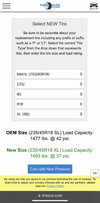Rule of thumb is to 1. stay below max cold inflation pressure of a given tire, with some margin of safety baked in, then 2. refer to the door sticker, manual for OEM recommendation and 3. perhaps strike a balance between the two based on many many different factors (with varying degrees of importance for each driver, climate, car use) including observed tire wear, set alignment, tire used, etc
MPP, for example, openly recommends raising the cold inflation tire pressure to 48psi all around for stock Ys and 3s, with either OE or fairly heavily modified suspension setup and ~ OE spec tires.
MPP, for example, openly recommends raising the cold inflation tire pressure to 48psi all around for stock Ys and 3s, with either OE or fairly heavily modified suspension setup and ~ OE spec tires.



